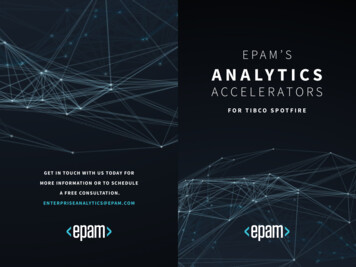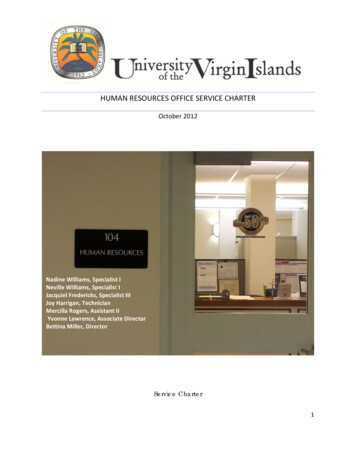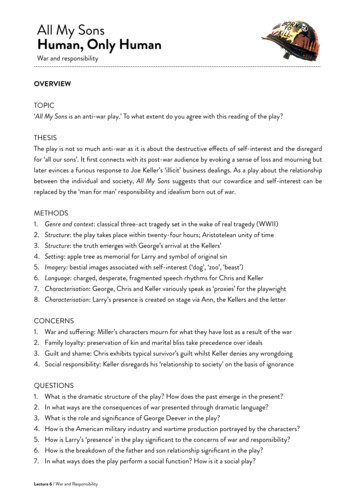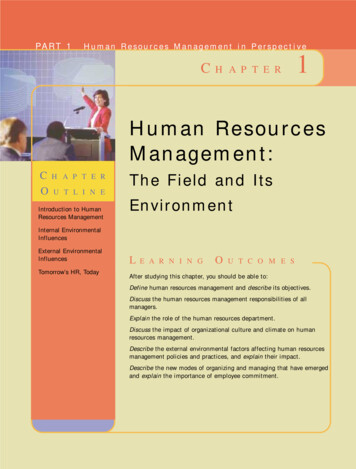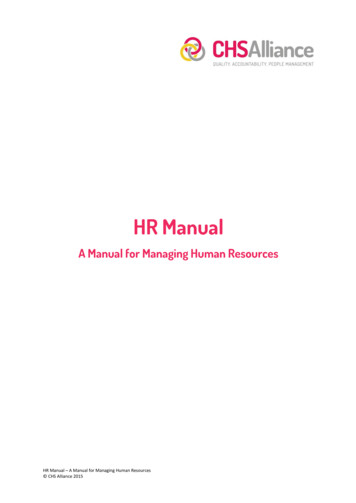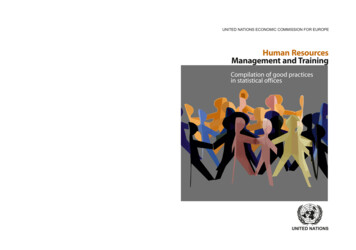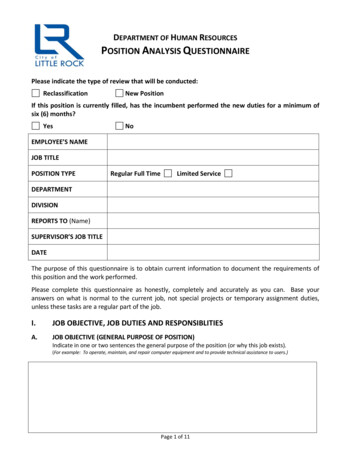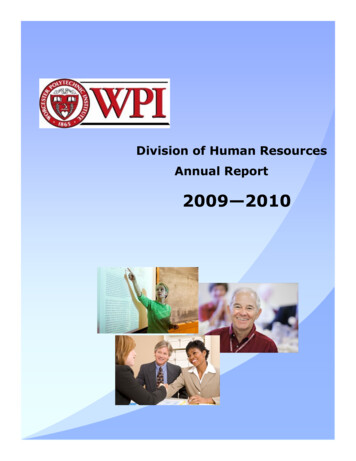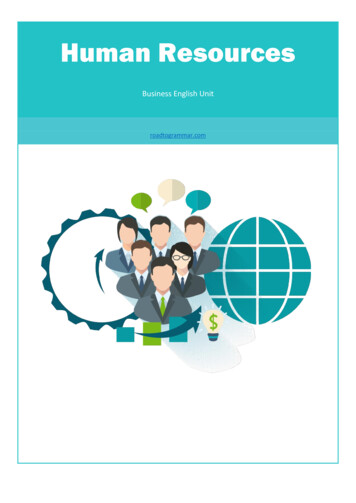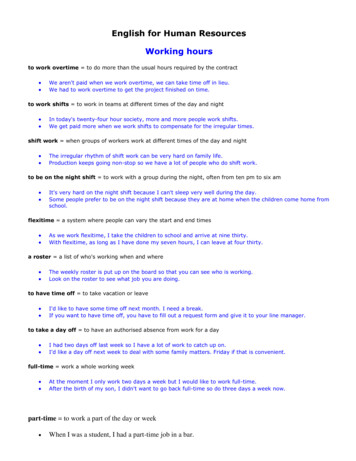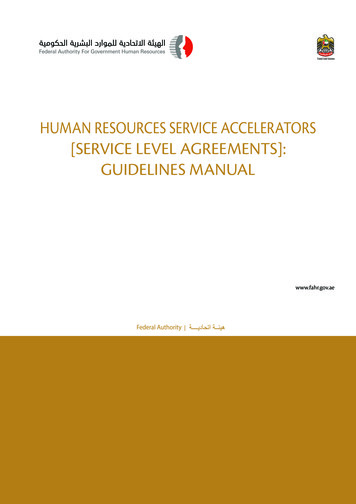
Transcription
HUMAN RESOURCES SERVICE ACCELERATORS[SERVICE LEVEL AGREEMENTS]:GUIDELINES MANUALwww.fahr.gov.ae
HUMAN RESOURCES SERVICE ACCELERATORS[SERVICE LEVEL AGREEMENTS]:GUIDELINES MANUALCopyright @ 2017 Federal Authority for Government Human Resources (FAHR)All rights reserved.No part of this manual may be used, reproduced, or transmitted in any form or media or by any means (electronic, mechanical,photocopying, recording, or any information storage and retrieval system) without the prior written permission of the FederalAuthority for Government Human Resources (FAHR), except as provided in the terms and conditions related to the usage of theAuthority’s publications.
“The best resources should be secured to equip UAE Nationals with education and knowledge, to refine their skills andexperiences, and to prepare them for accessing all work fieldsand be productive while demonstrating high ambitions anda sincere desire to sustain the country’s legacy of giving in allfields and under all circumstances”H.H. Sheikh Khalifa bin Zayed bin Sultan Al NahyanThe President of the UAE, and the Ruler of the Emirate ofAbu Dhabi
“The measure of a government’s success is the satisfaction ofthose who deal with it”H.H. Sheikh Mohammed bin Rashid Al MaktoumVice President and Prime Minister of the UAE,and the Ruler of the Emirate of Dubai
“Setting standards for enhancing services is Sheikh Khalifa’smain priority”H.H. Sheikh Mohammed bin Zayed bin Sultan Al NahyanCrown Prince of Abu Dhabi and Deputy Supreme Commander of the UAE Armed Forces
TABLE OF CONTENTSSr.No.PageNo.DescriptionAbout the Manual .5Definitions 61.Introduction .72.Human Resources Service Level Agreements .82.1Definition .82.2Why HR Service Level Agreements? .92.3Customers of HR Departments .102.4Roles and Responsibilities .112.5Characteristics of a Professional Service Level Agreement 132.6Service Level Agreement Life Cycle . . .142.7Components of a Human Resources Service Level Agreement .253.Measuring and Evaluating the Effectiveness of Implementing HumanResources Service Level Agreements 294.Conclusion 31Appendices .32An Initial List of Identified Service Levels for the HR Departmentsin the Federal Entities 33Appendix “A”:Appendix “B”: Frequently Asked Questions .38Appendix “C”: References .41Human Resources Service Accelerators [Service Level Agreements]: Guidelines ManualPage 4 of 41
ABOUT THIS MANUALThe “Human Resources Service Accelerators [Service Level Agreements]: GuidelinesManual” aims at supporting the Federal Entities in establishing and implementing soundHuman Resources Service Level Agreements (HR SLA’s) in order to instill a culture of serviceexcellence and customer satisfaction.In the first section of the manual, definitions of “Service”, “Service Level”, and “Service LevelAgreements” are provided. Then, the manual lists the benefits of having and implementing HRService Level Agreements. A clarification is provided with regard to the types of customerswhich the HR Departments serve as well as an emphasis on the importance of understandingtheir needs, requirements, and expectations. Moreover, the roles and responsibilities of allconcerned parties are mentioned in order to ensure governance and accountability. Themanual describes the characteristics of a professional Service Level Agreement and explainsthe five phases of its life cycle. In addition, it identifies the components of a HumanResources Service Level Agreement and provides relevant examples.The manual includes an initial list of HR service levels which are identified for the use of theHuman Resources Departments in the Federal Entities. It also contains a list of referencesthat may be utilized by readers for further reading on the subject of Service *****************************Human Resources Service Accelerators [Service Level Agreements]: Guidelines ManualPage 5 of 41
DEFINITIONSThe Manual:Human Resources Service Accelerators [Service LevelAgreements]: Guidelines Manual.Authority:Federal Authority for Government Human Resources.Employee:Any person who occupies a budgeted position in theFederal Entities.Federal Authority:Any ministry established by the Federal Law No. 1 for1972 regarding jurisdictions of the ministries and powersof the ministers and the laws amending thereof, or anyother authority, corporation, or Federal organizationalunit of the federal government.Customers:Internal or external receivers or users of a service. Theymay be individuals, groups or organizations.Service:An activity or series of activities of more or lessintangible nature that normally, but not necessarily, takeplace in interactions between a Customer and serviceemployees and / or physical resources or goods and / orsystems of the Service ProviderService Level:An agreed measure of quantity, quality, timeliness andcostusedtodescribe theperformanceof servicedelivery.Service LevelAgreement:A formal written agreement negotiated between theHuman Resources Department, as a service provider,and the service users stating the minimum level orquality of service the users require to meet theirbusiness *******************Human Resources Service Accelerators [Service Level Agreements]: Guidelines ManualPage 6 of 41
1.INTRODUCTIONThe UAE Government developed strategic enablers to empower federal and governmententities and assist them in fulfilling the country’s strategic priorities. Customer-centricservices is one of those enablers which the Federal Authority for Government HumanResources pledges to adhere to, through its commitment to quality, efficiency, andtransparency standards.The Authority constantly strives to introduce management practices and tools that arealigned with the UAE’s aspirations and which support the Human Resources Departmentsin the Federal Entities in providing added value to their Employees, business units, heestablishmentandimplementation of Human Resources Service Level Agreements (HR SLA’s), which arebased on a solid Human Resources strategy and are linked to the Entity’s priorities, willdefinitely lead to a better performance and a competitive advantage in an eracharacterized with rapid change and the need for wise utilization of available resources.Currently, there are several tools to gauge the performance of the Human ResourcesDepartments in the Federal Entities. One of them is the HR Balanced Scorecard and theother one is the “Emirates Award for Human Resources in the Federal Government”.Both of them require that the Federal Entities have adequate metrics to measure theeffectiveness of their Human Resources initiatives and to provide performance datawhich shows evidence of their dedication to continuous improvement. Having HumanResources Service Level Agreements in place will help the HR Departments in sheddinglight on efficiency as they focus on timeliness, cost-effectiveness, reliability, and qualityof services; thus, resulting in a holistic overview of the human resources-related effortstowards achieving effectiveness and ************************Human Resources Service Accelerators [Service Level Agreements]: Guidelines ManualPage 7 of 41
2.HUMAN RESOURCES SERVICE LEVEL AGREEMENT (HR SLA’S)Establishing a Service Level Agreement (SLA) is a sound management practice whichreflects a commitment towards efficiency and customer satisfaction. Therefore, anincreasing number of Human Resources Departments are formalizing their internalcustomer offering by means of Service Level Agreements (SLA’s).2.1DefinitionSuccessful organizations today treat their employees as customers; therefore,understandingtheir requirements,fulfilling their reasonable needs,andensuring their satisfaction are considered essential for better productivity andbusiness results.Before delving into the definition of a Service Level Agreement (SLA), it isimportant to understand the meaning of “Service” and “Service Level”. In his“Service Management and Marketing”, Christian Gronroos states that “Service”is “an activity or series of activities of more or less intangible nature thatnormally, but not necessarily, take place in interactions between a Customerand service employees and / or physical resources or goods and / or systems ofthe Service Provider”. As for “Service Level”, it is “an agreed measure ofquantity, quality, timeliness, and cost used to describe the performance ofservice delivery”.In light of the above, a Human Resources Service Level Agreement is definedas “a formal written agreement negotiated between the Human ResourcesDepartment, as a service provider, and the service users stating the minimumlevel or quality of service the users require to meet their business needs. It alsoincludes the information or level of cooperation the service provider requiresfrom its service users in order to provide quality support or assistance”.The Service Level Agreement (SLA) document is like a contract whichformalizes and clarifies the relationship between the Human ResourcesDepartment, as a service provider, and the service users. It is administrativelybinding; however, not legally enforceable.Human Resources Service Accelerators [Service Level Agreements]: Guidelines ManualPage 8 of 41
2.2Why HR Service Level Agreements?Having an HR Service Level Agreement in place enhances governance,accountability, and service quality. It brings along the following benefits to theHuman Resources Department, the Service Users, and the Entity:Human Resources DepartmentFocusing the HR Department time and resources on strategic aspects whilefulfilling its day-to-day operational issues in an effective and efficientmanner;Supporting the appropriate identification of HR service offerings andprocesses;Clarifying the HR Department role and gauging,andimprovingperformance.Service UsersArticulating the service users’ needs, requirements, and expectations;Clarifying the service users’ roles and responsibilities.EntityEnsuring alignment of the HR strategy with the Entity’s osteringcontinuousimprovement;Providing a mechanism for governance and issue resolution.Human Resources Service Accelerators [Service Level Agreements]: Guidelines ManualPage 9 of 41
2.3Customers of HR DepartmentsThe HR Departments in the federal government entities have Internal andExternal Customers. Internal Customers are Employees and internal businessunits (e.g. Finance Department, Operations Department, etc.); while Externalones are those parties which the HR Department interacts with concerning HRrelated issues. External Customers may be regulators (e.g. the FederalAuthority for Government Human Resources, Ministry of Human Resources andEmiratization, etc.), or government / private sector service providers (e.g.General Pension and Social Security Authority, insurance companies, manpoweragencies, etc.), or individuals (e.g. job candidates, etc.).Identifying the HR Department internal and external customers, as well asdefining their needs, requirements, and expectations will help in providingadequate services and acceptable service levels. Thus, resulting not only inhigher levels of satisfaction and productivity, but also in building smooth andstrong business relationships based on a win-win mindset as well asmaintaining a good image of the Entity.Some examples of the HR services provided to internal and external customersare as follows:CustomersExamples of Provided ServicesProcessing salary and service lettersEmployees(Internal Customers)Processing annual / sick leave requests:Processing annual tickets requestsProcessing school fee reimbursementrequestsProcessing recruitment formalitiesInternal Business Units(Internal Customers):Processing employee transfer requestsProcessing disciplinary and grievanceactionsProcessing of monthly feesExternal Parties(External Customers):Providing employee-related informationPreparing and submitting relevantreportsHuman Resources Service Accelerators [Service Level Agreements]: Guidelines ManualPage 10 of 41
2.4Roles and ResponsibilitiesInorder toestablish, implement, andimprove theHRService LevelAgreements, the following parties play a vital role when fulfilling their belowmentioned responsibilities:1. Federal Authority for Government Human ResourcesDevelop and update HR Service Level Agreements guidelines for the HRDepartments in the federal government;Provide advisory support services to the HR Departments on mattersrelated to HR Service Level Agreements;Monitor the results of implementing the HR Service Level Agreements.2. Human Resources DepartmentDefine the HR offerings and proposed service levels at the beginning ofeach calendar year;Identify the service users’ expectations and negotiate them to reach awin-win situation;Establish and document HR Service Level Agreements;Ensure that the HR Service Level Agreements result in efficient HRoperations;Create awareness on HR Service Level Agreement across the Entity;Identify relevant areas for development and suggest improvements tothe HR Service Level Agreements;Deliver on the commitments articulated in the Service Level Agreement.3. Strategic and Future DepartmentEnsure that the identified and implemented HR service levels are alignedwith the federal entity’s strategic direction;Assess service users’ satisfaction with provided HR offerings andrele
The HR Departments in the federal government entities have Internal and External Customers. Internal Customers are Employees and internal business units (e.g. Finance Department, Operations Department, etc.); while External ones are those parties which the HR Department interacts with concerning HR-related issues. External Customers may be regulators (e.g. the Federal Authority for Government .
